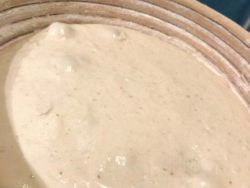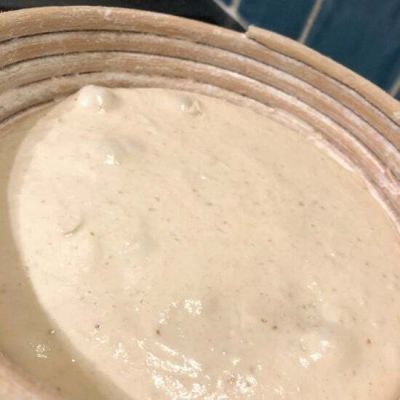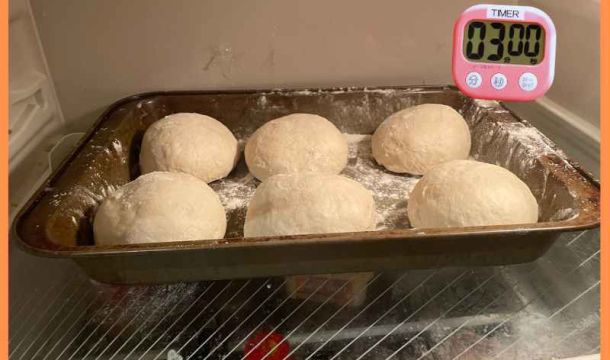
What Does Changing the Water Content of a Bread Recipe do?

How to tell if there is too much water in bread dough? The challenge of feeling comfortable adjusting the amount of water in a recipe can sound daunting, especially if you are new to making bread!
There are many things that impact how much water should be added to a dough. The most common one is how much water is able to be absorbed by the flour. These dough hydration factors mean that when you follow a bread recipe your bread is unlikely to turn out the same as the person who wrote it unless you have the same ingredients and baking environment.
So to make quality bread, it’s an important skill to master dough hydration. Don’t worry, as you make more and more bread, the ability to know if your doughs need more or less water will come naturally. This guide will just speed things up!.
What impacts the hydration capabilities of dough?
In this post, I’m going to explain the impact of getting the hydration levels wrong in bread dough and how you can achieve the perfect water-to-flour ratio. But before we get onto this, let’s cover what impacts the hydration levels of a dough. Here’s a sexy list of examples:
The level of protein in the flour
Protein absorbs water to enable it to flex into gluten. The more protein in the flour, the more water is required to effectively hydrate the dough (conversion rate given below).
The characteristics of the flour
It’s not just the amount of protein available – that would be easy to work out. It’s really the quality of the protein and the make-up of the flour. Whether the flour is hard, or soft wheat, where it’s grown and the processes used to extract it will also impact the amount of water it will absorb.
The humidity of the room
In high pressured environments, water doesn’t move as freely. This makes it harder for the flour to absorb. If the flour is kept in a humid area previously it will also contain more moisture.
The temperature of the dough
As the dough is kneaded, it tends to warm up, making it sticky. This can lead us to think there is too much water in it and reaching for a handful of flour. Cooler temperatures reduce yeast activity to give the flour more time to absorb the water gently.
What does this tell us?
Well, there are so many variables that go into bread dough it is no wonder home bakers sometimes end up with a slippery mess when they recite a recipe! If you’ve followed a bread recipe and you’re not sure whether to adjust the amount of water in it, we’ll cover that in a moment.
Head over to the dough hydration page to see how to calculate the amount of water used in a recipe and find out more.
What does increasing the water in a bread recipe do?
I’ll let you in a little secret. It’s all about the crumb.
Wetter doughs encourage gluten strands to get nice and long. This helps to form bread with an open crumb. Though it’s not the only factor, the maturity of the dough is just as important, for example. Bread made with more water will usually contain more moisture after baking, making it softer.
What happens if you add too much water to bread dough?
Too much water interferes with gluten. It will weaken the dough structure by preventing it from being able to support the weight of the water. The common feature of dough with too much water is an uneven crust making you think your shaping skills aren’t up to scratch. It can also lead to a dense crumb with big holes throughout.
What does decreasing water in a bread recipe do?
Too little water in a dough prevents the gluten from becoming as extensible as it should. This is great for proofing free-standing bread (without using a banneton or tin), but it also makes the gluten structure more compact.
How to tell if there is not enough water in the recipe
If the water in the recipe isn’t sufficient, the dough will feel dry and be unable to stretch easily. This slows down the proofing process. It can also damage the dough structure as there isn’t enough water for the gluten to unravel and stretch.
The initial stages of mixing are the most important for hydrating the gluten. This means adding extra water to the dough should occur as soon as possible to avoid trying to build a structure from poorly hydrated gluten.
Why the water ratio is important in weaker flours
During the milling stage, some of the protein will be damaged. This happens in every flour although different brands will have varying rates of damaged and healthy protein.
Allowing time to properly hydrate the damaged particles helps them to repair. This is especially noticeable in low protein or all-purpose flour. These flours need to be hydrated properly at the early stages to gently soak and repair the damaged gluten. Doing this aids the gas retaining properties of the dough.
Getting the dough hydration levels right from the start in doughs with weaker flour is crucially important. Adding more water or flour later on in the process will help somewhat however make a note of the adjustment and adapt the recipe. When you attempt the recipe again you notice better results.
But what about a soft crumb with a tight gluten structure?
That’s a little more complicated. View the how to get a softer crumb article to find out more – when I’ve written it!
How to achieve the best water hydration
One of the most important ways to ensure your recipe is accurate is to weigh the ingredients accurately. Using cups to measure is not going to achieve this. All bread ingredients should be weighed in grams, including the water. If you don’t already have a decent set of scales for bread making, here’s a link to the scales I treasure:

View the latest price on Amazon
Top 9 tips for perfect water hydration:
- Follow a recipe from a reliable source using grams
- Determine the Desired Dough Temperature and make checks throughout
- Feel the dough as you combine the water – get used to how it feels
- If you think you need to add flour or water, do so at the earliest instance, 2% at a time
- Feel the dough at the end of mixing
- Feel the dough during the first rise, if it’s too wet, extend it by putting it in the fridge overnight
- At shaping, feel the dough. Does it feel sticky, wet or dry?
- Make a note of any adjustments for next time
- Repeat the recipe using the same flour until you get a dough that feels healthy
How does the amount of water affect bread?
The amount of water affects the bonding of the gluten network. A high water content dough creates a more open crumb, whereas, dryer doughs provide a more close-knit network. There can be issues when the dough is too wet or too dry. Knowing the dough hydration capabilities of your flour will benefit the quality of your bread greatly.
As you can see, feeling the dough is the only way to understand what dough should feel like at each stage. This is why I recommend mastering a single recipe before branching out to other styles. Get to know the recipe, ingredients, and improve your techniques and knowledge. Then transfer your skills to others.
For more ways to change or enhance bread, check out the how to improve bread homepage.
Frequently asked questions about dough hydration
If you’ve enjoyed this article and wish to treat me to a coffee, you can by following the link below – Thanks x

Hi, I’m Gareth Busby, a baking coach, head baker and bread-baking fanatic! My aim is to use science, techniques and 15 years of baking experience to help you become a better baker.
Table of Contents
- What impacts the hydration capabilities of dough?
- What does this tell us?
- What does increasing the water in a bread recipe do?
- What does decreasing water in a bread recipe do?
- How to achieve the best water hydration
- Top 9 tips for perfect water hydration:
- How does the amount of water affect bread?
- Frequently asked questions about dough hydration
Related Recipes
Related Articles
Keep up to date with the latest Articles, Recipes & Bread Baking info by joining my mailing list
Join The Weekly Bread Baker's Newsletter!
Latest Articles
Baking Categories
Disclaimer
Address
8 Woodland Avenue,
Worthing
West Sussex
BN13 3AF
UK








Leave a Reply